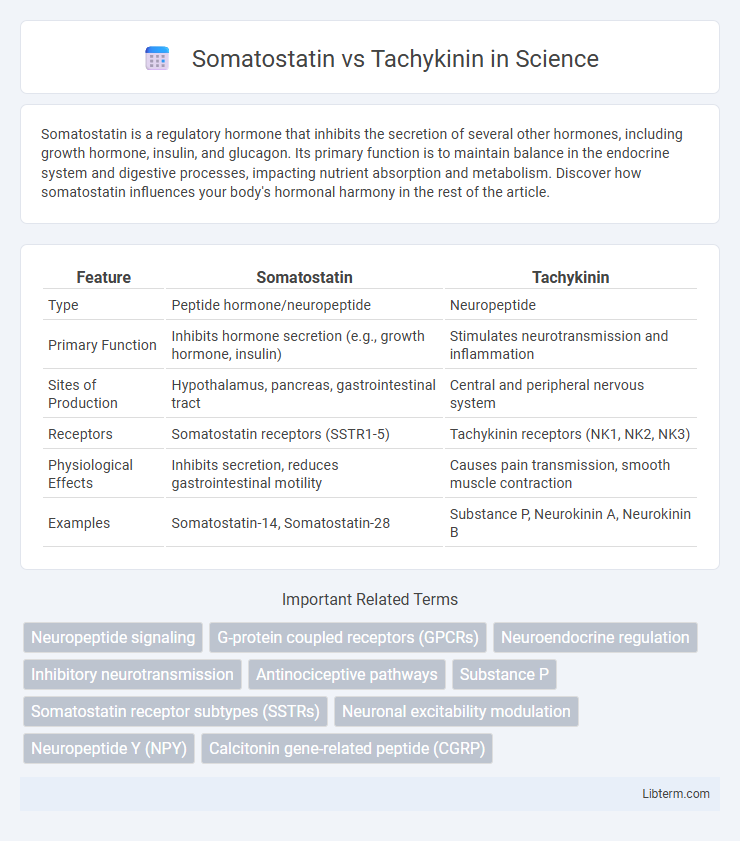Somatostatin is a regulatory hormone that inhibits the secretion of several other hormones, including growth hormone, insulin, and glucagon. Its primary function is to maintain balance in the endocrine system and digestive processes, impacting nutrient absorption and metabolism. Discover how somatostatin influences your body's hormonal harmony in the rest of the article.
Table of Comparison
| Feature | Somatostatin | Tachykinin |
|---|---|---|
| Type | Peptide hormone/neuropeptide | Neuropeptide |
| Primary Function | Inhibits hormone secretion (e.g., growth hormone, insulin) | Stimulates neurotransmission and inflammation |
| Sites of Production | Hypothalamus, pancreas, gastrointestinal tract | Central and peripheral nervous system |
| Receptors | Somatostatin receptors (SSTR1-5) | Tachykinin receptors (NK1, NK2, NK3) |
| Physiological Effects | Inhibits secretion, reduces gastrointestinal motility | Causes pain transmission, smooth muscle contraction |
| Examples | Somatostatin-14, Somatostatin-28 | Substance P, Neurokinin A, Neurokinin B |
Introduction to Somatostatin and Tachykinin
Somatostatin is a peptide hormone that regulates endocrine and nervous system functions by inhibiting the release of numerous secondary hormones such as growth hormone, insulin, and glucagon. Tachykinins are a family of neuropeptides, including substance P, that primarily mediate neurotransmission and inflammatory responses through receptors like NK1, NK2, and NK3. Both somatostatin and tachykinins play crucial roles in cell signaling but exhibit contrasting effects on physiological processes such as hormone secretion and pain perception.
Molecular Structure and Biosynthesis
Somatostatin is a cyclic peptide hormone composed of 14 or 28 amino acids, synthesized primarily in the hypothalamus, pancreas, and gastrointestinal tract through cleavage of a larger preprosomatostatin precursor. Tachykinins, including substance P and neurokinin A, consist of linear peptides ranging from 10 to 11 amino acids, derived from distinct preprotachykinin genes via alternative splicing and proteolytic processing. The molecular structure of somatostatin, characterized by a disulfide bridge forming a ring, contrasts with the linear, amidated C-terminus of tachykinins, influencing their receptor binding and biological activity.
Mechanisms of Action
Somatostatin exerts its effects by binding to G-protein coupled somatostatin receptors, inhibiting adenylate cyclase activity and reducing intracellular cAMP levels, which suppresses hormone secretion and neurotransmission. Tachykinins, such as substance P, activate neurokinin receptors (NK1, NK2, NK3) that stimulate phospholipase C, increasing intracellular calcium and promoting neurotransmitter release and smooth muscle contraction. The mechanistic contrast lies in somatostatin's inhibitory modulation via receptor-mediated suppression of second messenger pathways versus tachykinins' excitatory signaling that amplifies cellular responses through calcium-dependent pathways.
Receptor Subtypes and Distribution
Somatostatin receptors (SSTR1-5) are G-protein-coupled receptors predominantly distributed in the central nervous system, pancreas, and gastrointestinal tract, mediating inhibitory effects on hormone secretion and neurotransmission. Tachykinin receptors, including NK1, NK2, and NK3 subtypes, are widely expressed in the brain, smooth muscles, and immune cells, facilitating excitatory signaling related to pain, inflammation, and smooth muscle contraction. The distinct receptor subtype distribution underlies the differing physiological roles of somatostatin as an inhibitory neuropeptide and tachykinins as excitatory neurotransmitters.
Physiological Functions
Somatostatin regulates endocrine and exocrine secretions by inhibiting the release of hormones such as growth hormone, insulin, and glucagon, playing a critical role in maintaining homeostasis. Tachykinins, including substance P and neurokinin A, mediate neurotransmission, promote smooth muscle contraction, and regulate inflammatory responses, especially in pain signaling pathways. Both peptides influence autonomic nervous system functions but differ significantly in their receptor targets and physiological outcomes.
Role in Neurotransmission
Somatostatin functions as an inhibitory neurotransmitter, modulating neuronal excitability and reducing the release of excitatory neurotransmitters such as glutamate. Tachykinins, including substance P, act as excitatory neurotransmitters that promote neurotransmission by facilitating the release of neuropeptides and enhancing synaptic transmission. These neuropeptides play contrasting roles in pain modulation, with somatostatin dampening nociceptive signals and tachykinins amplifying pain pathways.
Involvement in Disease States
Somatostatin plays a critical role in regulating hormone secretion and exhibits inhibitory effects on tumor growth, making it significant in diseases like acromegaly, neuroendocrine tumors, and type 2 diabetes. Tachykinins, including substance P, are involved in inflammatory responses and pain signaling, contributing to conditions such as asthma, arthritis, and neurodegenerative diseases. Dysregulation of somatostatin and tachykinin pathways affects disease progression, highlighting their importance as therapeutic targets in endocrine disorders and inflammatory diseases.
Therapeutic Applications and Drug Development
Somatostatin analogs are widely used in treating endocrine tumors, acromegaly, and gastrointestinal disorders by inhibiting hormone secretion and cell proliferation, while tachykinin receptor antagonists show promise in managing inflammatory diseases, pain, and respiratory conditions such as asthma and chronic cough. Drug development for somatostatin focuses on enhancing receptor subtype selectivity and prolonging half-life to improve efficacy and reduce side effects, whereas tachykinin-related therapies aim to block neurokinin receptors (NK1, NK2, NK3) to modulate neurogenic inflammation and nociception. Both peptide families represent critical targets in pharmacology due to their roles in signaling pathways implicated in diverse pathologies and ongoing clinical trials underscore their potential in novel therapeutic modalities.
Comparative Analysis: Somatostatin vs Tachykinin
Somatostatin is a peptide hormone that inhibits the release of numerous secondary hormones, regulating endocrine and nervous system functions, whereas tachykinins, such as substance P, primarily promote neurotransmission and inflammatory responses. Somatostatin binds to five G-protein-coupled receptor subtypes (SSTR1-5), mediating inhibitory effects, while tachykinins activate neurokinin receptors (NK1, NK2, NK3) to induce excitatory signaling. The contrasting roles of somatostatin's inhibitory modulation versus tachykinin's excitatory actions highlight their opposing mechanisms in neuroendocrine communication and immune response.
Future Directions and Research Trends
Future research on somatostatin and tachykinin focuses on their receptor-specific modulators to develop targeted therapies for neurological and inflammatory disorders. Advances in gene editing and molecular imaging techniques enable precise mapping of somatostatin and tachykinin pathways, enhancing understanding of their roles in pain modulation and neurodegeneration. Emerging trends emphasize integrating multi-omics data to identify biomarkers for personalized treatment approaches involving these neuropeptides.
Somatostatin Infographic

 libterm.com
libterm.com